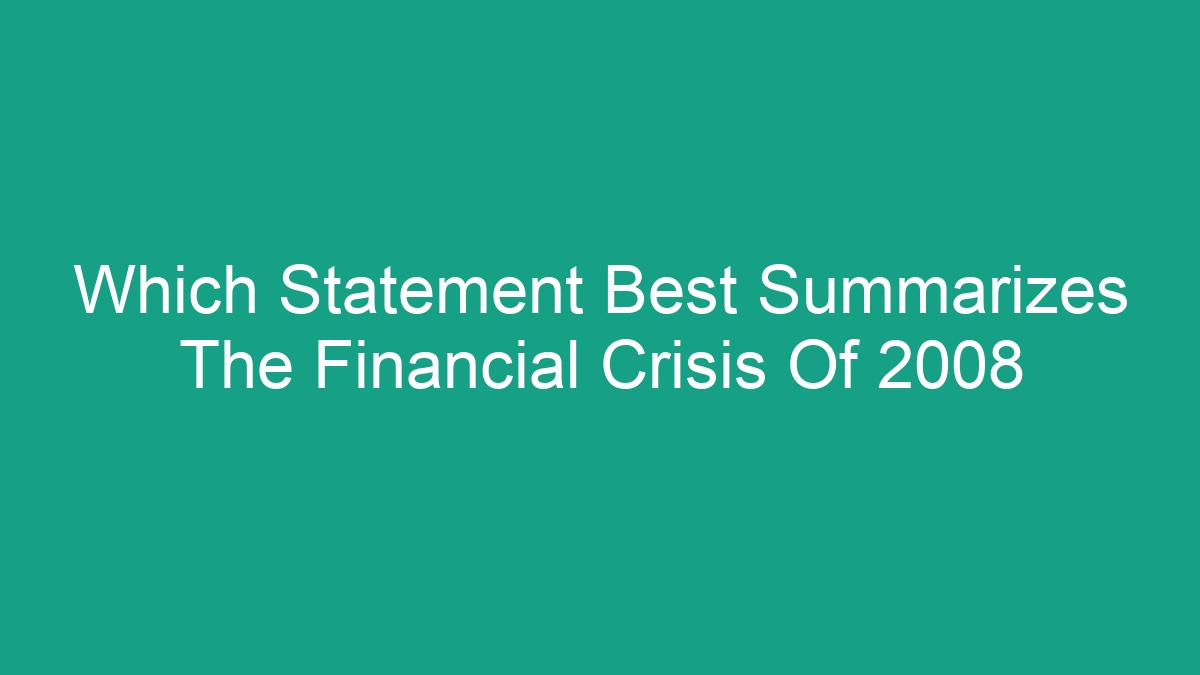
The financial crisis of 2008, also known as the global financial crisis, was a severe worldwide economic crisis that occurred in the late 2000s. It was the most serious financial crisis since the Great Depression (1929). The crisis had widespread effects on the global economy and ultimately led to the Great Recession.
Causes of the Financial Crisis
The financial crisis of 2008 had multiple causes, including:
1. Housing Bubble: The housing bubble, particularly in the United States, was a significant factor in the financial crisis. It was characterized by a rapid increase in housing prices fueled by high demand and speculation.
2. Subprime Mortgages: Lenders were increasingly offering subprime mortgages to borrowers with poor credit histories. These mortgages were bundled into complex financial products and sold to investors, leading to widespread financial instability when the housing market collapsed.
3. Financial Deregulation: Deregulation in the financial sector allowed banks to engage in risky practices, such as excessive borrowing and lending, contributing to the crisis.
4. Financial Innovation: The development of complex and opaque financial instruments, such as collateralized debt obligations (CDOs) and credit default swaps, amplified the risks in the financial system.
Impact of the Financial Crisis
The financial crisis of 2008 had far-reaching impacts on the global economy, including:
1. Bank Failures: Many financial institutions, including major banks, faced insolvency and had to be bailed out by governments or acquired by stronger banks.
2. Stock Market Crash: Stock markets around the world experienced sharp declines, erasing trillions of dollars in market value.
3. Global Recession: The crisis led to a severe economic downturn, with many countries experiencing negative GDP growth and rising unemployment.
4. Housing Market Collapse: The housing market suffered a significant downturn, leading to millions of foreclosures and a decline in housing prices.
Responses to the Financial Crisis
In response to the financial crisis, governments and central banks implemented various measures to stabilize the financial system and stimulate economic growth, including:
1. Bailouts: Governments provided financial assistance to troubled banks and financial institutions to prevent further collapse of the financial system.
2. Monetary Policy: Central banks lowered interest rates and engaged in quantitative easing to increase the money supply and encourage lending.
3. Fiscal Stimulus: Governments enacted stimulus packages, including infrastructure spending and tax cuts, to boost economic activity.
4. Regulatory Reforms: Policymakers implemented reforms to strengthen financial regulation and oversight to prevent a similar crisis from occurring in the future.
The Best Statement to Summarize the Financial Crisis of 2008
The best statement to summarize the financial crisis of 2008 is:
“The financial crisis of 2008 was a result of the housing bubble, subprime mortgage crisis, financial deregulation, and complex financial instruments, leading to bank failures, stock market crash, global recession, and extensive government interventions to stabilize the financial system and stimulate economic growth.”
This statement encapsulates the key causes, impacts, and responses to the financial crisis, providing a comprehensive summary of the events that unfolded during this tumultuous period in global financial history.
In conclusion, the financial crisis of 2008 was a watershed moment that had profound and lasting effects on the global economy. It exposed the vulnerabilities and risks inherent in the financial system and prompted significant changes in financial regulation and oversight. By understanding the causes and consequences of the crisis, policymakers and financial institutions can better prepare for and mitigate the impact of future financial crises.



